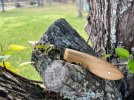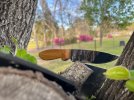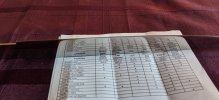DeadPineKnives
Gold Member
- Joined
- Nov 25, 2024
- Messages
- 200
DISCLAIMER: I am not attempting to sell knives on BladeForums at this time, as I do not have the correct membership yet, so I'm gonna keep this sort of vague.
For the past few years I've been making sort of roughneck knives with the intention that they'd be more likely to be bought by people who would actually use them, but lately I've been fascinated with Bob Loveless and other old-time knife makers that went above and beyond the call of duty to make a truly excellent knife, and over the past few months I've become dissatisfied with my own work and wish to advance my skills!
The main thing I've been having trouble with is nice finishing. To me, until recently, a "nice finish" involved 60 grit, 120 grit and a surface conditioning belt, but that simply blends everything together and hides rogue scratches.
What I want is a true mirror polish, like Bob Loveless did on his knives, using only a grinder and buffer without hand sanding involved. The only issue is that my knives are mainly convex, which means that unlike a flat bevel or hollow grind, the entire bevel is not in contact with the grinder all at once, which introduces the potential for missing spots and creating unwanted facets.
Does anyone have any advice for how I can achieve this? My main issue seems to be removing rogue scratches as I climb up the grits...
For the past few years I've been making sort of roughneck knives with the intention that they'd be more likely to be bought by people who would actually use them, but lately I've been fascinated with Bob Loveless and other old-time knife makers that went above and beyond the call of duty to make a truly excellent knife, and over the past few months I've become dissatisfied with my own work and wish to advance my skills!
The main thing I've been having trouble with is nice finishing. To me, until recently, a "nice finish" involved 60 grit, 120 grit and a surface conditioning belt, but that simply blends everything together and hides rogue scratches.
What I want is a true mirror polish, like Bob Loveless did on his knives, using only a grinder and buffer without hand sanding involved. The only issue is that my knives are mainly convex, which means that unlike a flat bevel or hollow grind, the entire bevel is not in contact with the grinder all at once, which introduces the potential for missing spots and creating unwanted facets.
Does anyone have any advice for how I can achieve this? My main issue seems to be removing rogue scratches as I climb up the grits...



